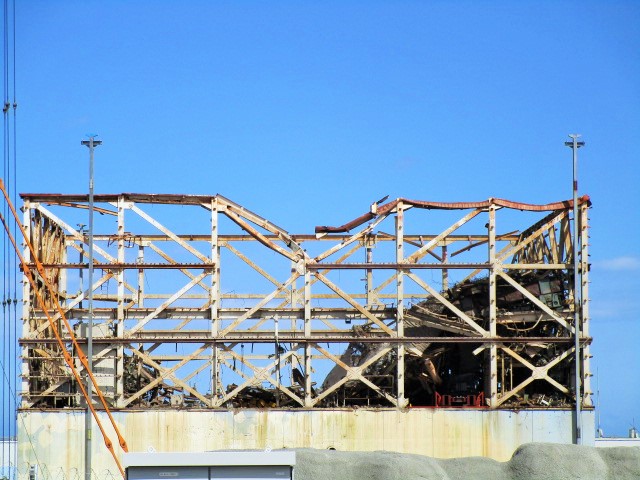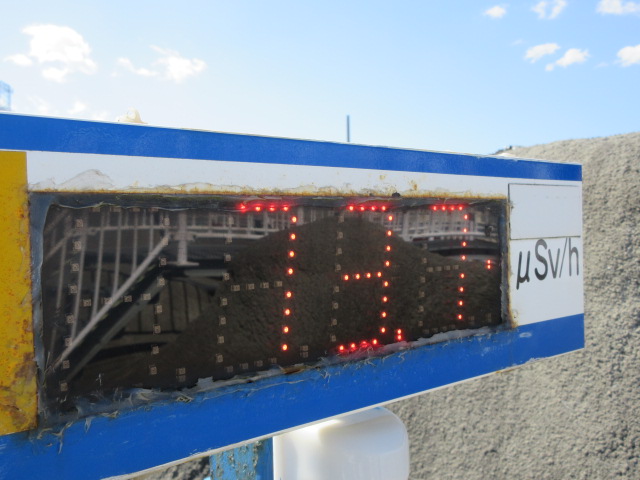Report on the 2023 Fukushima Prefectural Residents’ Rally for Achieving a Nuclear-Free Fukushima and Tokyo Electric Power Company (TEPCO) Fukushima Daiichi Nuclear Power Station Tour
By Ito Fumika (Editor and Writer)
On March 19, 2023, the author participated in the 2023 Fukushima Peoples’ Rally for Achieving a Nuclear-Free Fukushima held in Iizaka Town, Fukushima City. The main auditorium of Paruse Iizaka was occupied by 900 participants who gathered from around the nation. This was the first time such a full-scale rally had been held in four years due to the COVID-19 pandemic, during which the holding of large-scale gatherings was avoided.
During these four years in Japan, many things have happened which question what the repeatedly-mentioned “retrospective considerations and lessons of the nuclear accident” really means. One of them is a move by the Japanese government, which has decided to discharge contaminated water (“ALPS-treated water”) into the ocean, although it had promised not to dispose of the water in any manner without the agreement of the people concerned. Campaigns opposing the discharge are being conducted right across Japan, including Fukushima, fishery communities across the country, and international parties who are connected by way of the ocean. Another happening is that the Japanese government has resumed a nuclear power promotion policy as one of the responses to the Russian invasion of Ukraine. Public opinion polls taken by newspapers indicate that since last year, those in favor of nuclear power generation outnumber those against.
These were the two major issues addressed at this rally: the government-led offshore discharge of contaminated water and the switch in nuclear policy to revert to an active promotion of nuclear power generation. In the opening address, Planning Committee Chairperson Tsunoda Masashi said: “Since immediately after the March 2011 nuclear power station accident, we requested the decommissioning of the Fukushima Daini Nuclear Power Station, demanding that Fukushima Prefecture should be free from nuclear power. Voices demanding this nuclear-free policy spread widely across the entire prefecture through people’s actions. In July 2019, the decommissioning of the Fukushima Daini was decided. That meant that no nuclear power plant would operate in Fukushima in the future. It was the moment when a nuclear-free Fukushima was achieved by the voices of people here. However, the Green Transformation (GX) basic policy recently announced by the government states that nuclear plants should be used for as long as possible given that safety is the top priority, and that nuclear plants may be replaced with next-generation ‘innovative’ reactors. The change in nuclear policy is giving rise to voices of anger, questioning whether the Fukushima Daini reactors might be replaced with such next-generation ‘innovative’ reactors. If safety is the top priority, the only solution is to give up nuclear power. I would like to discuss these issues with all different generations.”
The session “Messages from Fukushima” presented Sugeno Seiju, an organic farmer in Nihonmatsu City; Nanaumi Shiori, a member of the group DAPPE (Democracy Action to Protect Peace and Equality), which consists of the younger generation from teens to thirties in Fukushima; and Kanno Hiroshi, a former Iitate Village municipal worker. The three looked back over the twelve years since the accident, stressing that “the forced discharge of ALPS-treated water should be stopped.”
Anxiety about the unforeseeable future
In the next session, “Opinions of the Youth,” High School Peace Ambassadors Hashimoto Kaho, Hoshi Miu, Endo Hikaru, and Nakajo Suzune delivered a speech: “Twelve years ago, we swore that we would not forget the nuclear accident. We were assured that nuclear power would no longer be necessary. But such voices and opinions are fading away. It may be difficult to maintain motivation as actors in the post-accident society, but this fading away of the determination to be nuclear-free is a great disappointment. We are also disappointed by the deterioration in the international situation, and by the recent situation where mass opinions are manipulated (ignoring the thoughts of the people of Fukushima). We Peace Ambassadors appeal from Fukushima to prevent future generations from experiencing the difficulties we and those of our generation did. In our childhood, we had to live in separation from our close family members and friends. We had to spend many days inside our houses because outdoor activities were restricted. As schoolchildren we carried a dosimeter and were tested using a whole-body counter. Throughout our lifetime we will always need to think about the influence of the exposure to radiation on our own bodies. Our childhood days were very special in many ways. The operation of a nuclear power plant involves risks that may cause irremediable damages once an accident occurs. While nuclear plant operation is so dangerous, it has been given a green light by a majority decision of the Nuclear Regulation Authority, whose fairness is in question. The NRA emphasizes the necessity of a stable power supply due to energy cost increases and presents ear-pleasing merits of nuclear power. The lessons of Fukushima are being forgotten and the responsibilities we need to bear are growing” (Hashimoto). “To be honest, when I heard of treated water, I didn’t understand what it might be. It was very difficult to judge what was correct. Many residents in Fukushima do not agree with the water discharge into the ocean. Why did the government decide it so quickly? Until when will we need to endure it? What I am especially concerned about is that there is no clear way out. I hear people say, with an air of resignation, the government would do it whatever we say. Such decisions are made not because people in this country agreed with them, but because the accident is fading from people’s memory. These circumstances are making it more difficult to deliver the voice of opposition to the water discharge. It is critical that all of us are aware that this is our own problem.” (Nakajo).
Risk communicator as harm

The remains of the Unit 1 reactor building. For security reasons, it is not permitted to take photos of the area below this.
On the next day, March 20, the author participated in a TEPCO-organized tour to Fukushima Daiichi Nuclear Power Station. Our group consisted of nine people, including Yamaguchi Yukio, Ban Hideyuki and Takano Satoshi of the Citizens’ Nuclear Information Center (CNIC), as well as participants in the Fukushima Prefectural Residents’ Rally. Our first destination was the TEPCO Decommissioning Archive Center in Tomioka Town, which is a face-lift of the former PR center of the Fukushima Daini NPS. We toured the Center with explanations and then moved to Fukushima Daiichi NPS in a bus chartered by the operator. There were four guides in the Archive Center and Fukushima Daiichi NPS, but our main guide was deputy site supervisor Kimoto Takahiro, Fukushima Daiichi Decontamination & Decommissioning Engineering Company D&D Communication Center, who was a “risk communicator” (whose duties are to announce the risks of TEPCO nuclear plants and communicate with citizens).
As soon as we arrived at Fukushima Daiichi, we spotted the wall of the entrance-exit control building, on which a long list of cooperating companies was shown, supporting the guide’s explanation that “we are proceeding with decommissioning in cooperation with many partners.” According to the explanation, concrete has been laid throughout the station premises to prevent radioactive substances from being stirred up, and thus to allow humans to enter the power station grounds in normal clothes. We wore a thin vest, antivirus gloves and a personal dosimeter, and entered the station by bus. From the bus we toured the facilities, including the three Advanced Liquid Processing System (ALPS) units, waste incineration equipment, the vehicles used at the time of the accident, and pipes that carry contaminated water, among other things.
We were allowed to descend from the bus only in the raised area named “Reactors No. 1 to 4 building viewing area,” 80 to 100 meters distant from the reactor buildings and 35 meters above sea level. The floor of the area was made from woven metal wire, and the fences were constructed from steel pipes. Mr. Kimoto said: “The radioactive doses are very high here, 70 to 80 microsieverts per hour. We can stay here only a short time”. “(If we tour throughout the site) we would be exposed to a dose equivalent to two teeth X-rays,” Mr. Kimoto also said nonchalantly. We saw twelve workers in protective suits walking down the staircase of Unit 1 to the administrative building. 4,600 workers are working on the site daily. Only a few hundred of them are workers actually employed by TEPCO.
We saw a few of the 1,000 treated-water storage tanks from the bus. “Just as before the accident, tritium cannot be removed; therefore, water including tritium is stored in the tanks. It is called ALPS-treated water. We have discussed with the national government that we hope to discharge it into the ocean as a final disposal method. We have been given permission to do so and are building facilities for this purpose. We thought we should show you the treated water at the end of the tour. The water in this bottle is the actual treated water,” says Mr. Kimoto. Mr. Ban of CNIC asked, “Could you give me some of the water?” but this request was turned down. Mr. Yamaguchi of CNIC said, “It is meaningless to try to detect tritium, which emits beta rays, with a gamma ray detector.” In response, Mr. Kimoto said: “We would like to try to explain without causing misunderstandings, while also receiving critical comments.” This was real miscommunication.
I heard the TEPCO guides say: “At the time of water discharge into the ocean, a final analysis will be conducted to see what radioactive substances remain and what substances have been removed and at what concentrations the remaining substances are included. The water will then be put through the dilution system, because we are aware that seventy percent of the ALPS-treated water does not satisfy the restrictions for offshore discharge.” TEPCO also repeatedly said, “Even before the accident, tritium itself was discharged. The concentration of the treated water is not so different from that in the water discharged before the accident.” However, this does not mean offshore discharge is permissible if the concentrations are similar to those in the water discharged before the accident. Post-accident considerations and lessons can be effectively used not only by taking measures to prevent accidents, but also by reviewing how society operated and existed and how humans lived before the accident, as well as by changing society and its lifestyle. TEPCO was overconfident before the accident; it never expected an accident to happen. The operator should never be allowed to run in the same way as before the accident. During the tour, we witnessed the harm of the risk communicator, who ventured to restore faith by repeating in a superficially polite, gentle manner: “To decommission the reactors, there is no choice but to discharge the treated water into the ocean.”


